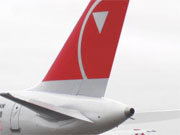September 15, 2005
 |
| A traveler walks beyond Northwest Airlines signage visible on stanchion strapping inside its terminal at O'Hare International AIrport September 14, 2005 in Chicago, Illinois. (Tim Boyle/Getty Images ) |
New York, NY — In Northwest Airlines' 24-page bankruptcy declaration, CEO Doug Steenland says soaring fuel prices coupled with uncompetitive costs forced the airline into bankruptcy
Steenland explains that Northwest avoided bankruptcy as long as it did primarily by borrowing money and selling assets. That strategy, Steenland says, had the unfortunate consequence of leaving Northwest with unsustainable debt burden.
University of Chicago Law School professor Douglas Baird, who's followed United Airlines' bankruptcy, says Northwest needs to immediately establish a legal framework for continuing to do business. He says that's what Northwest began doing in its first Chapter 11 court proceeding.
"You need to continue to run the airline. You need to continue to be able to pay for the jet fuel, to be able to pay your employees and handle those ongoing operations," according to Baird.
The court approved numerous motions that will allow Northwest to function -- authorization to pay $55 million to vendors for services during the mechanics strike, and to make good on back pay owed primarily to Northwest pilots.
The court gave Northwest until mid-January to file a reorganization plan and financial disclosures detailing its assets, liabilities.
There were no early motions asking the court to impose wage and benefit cuts on Northwest's workforce.
But in the declaration Steenland says Northwest quickly needs contract concessions from its pilots, flight attendants, ground workers and other unions. The head of Northwest's pilots' union says management told the pilots it wants labor cost cutting discussions resolved by no later than November.
Regarding the Aircraft Mechanics Fraternal Association, Steenland says there's no need to reopen the mechanics union's contract which Northwest put in place when union mechanics went on strike.
Steenland acknowledges Northwest employees will experience hardships by having to accept "market-based compensation and working conditions." But Steenland calls the alternative to restructuring labor costs "unacceptable" because it would require the liquidation of the company and the loss of all Northwest jobs. To reward the airline's workforce, Steenland proposes sharing 10 percent of all profits after the first million dollars with the employees who remain with carrier.
While Steenland calls a Northwest liquidation "unacceptable," whether Northwest will emerge from bankruptcy will be up to the court which will take into account not only Northwest's arguments but those of its creditors.
United Airlines has been in Chapter 11 bankruptcy for nearly three years, but is planning to emerge early next year with nearly $7 billion in annual cost reductions.
In the case of United, University of Chicago law professor Douglas Baird says creditors will end up with stock in the new airline equal to just pennies for each dollar they are owed.
"Well, basically, you can't get blood from a stone," he says. "If I have $100 and I owe $500, I'm not going to pay my creditors in full; that's just reality. Bankruptcy isn't letting them off of the hook. Bankruptcy is just allowing everybody to look at what there is and to confront the realities that if there are more liabilities than there are asset then people aren't going to be paid in full. In United we see creditors getting paid four to seven cents on the dollar."
Following Northwest's Chapter 11 filing on Wednesday, Steenland told reporters in a conference call that Northwest hopes to move through bankruptcy relatively quickly.
"Our goal is to look to restructure the company expeditiously. I think we have a very clear view as to what we need to get done and to do so in a prompt manner. Now what that means in terms of an overall time I am reluctant to make any particular predictions."
Steenland did say, however, that Northwest doesn't expect its bankruptcy restructuring to last "anywhere near the three year period that has been the case for United."




